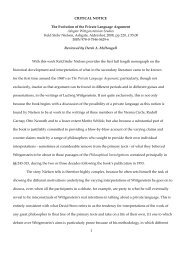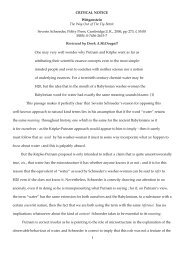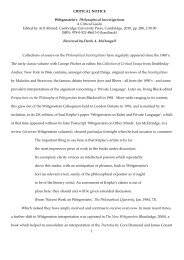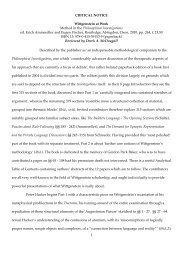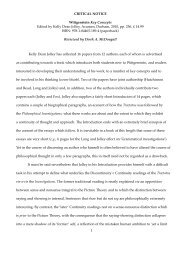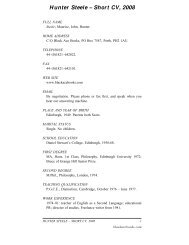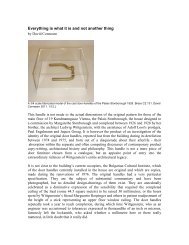CRITICAL NOTICE The Enchantment of Words Wittgenstein's ...
CRITICAL NOTICE The Enchantment of Words Wittgenstein's ...
CRITICAL NOTICE The Enchantment of Words Wittgenstein's ...
You also want an ePaper? Increase the reach of your titles
YUMPU automatically turns print PDFs into web optimized ePapers that Google loves.
As I argued..., a sign/symbol confusion can be seen behind<br />
the con-formist story. No one thinks that one might discover<br />
rules for the use <strong>of</strong> signs, since ‘the sign is arbitrary’...But also,<br />
no one thinks that one might discover rules for the use <strong>of</strong> symbols,<br />
since when considered as symbols, we take for granted how the<br />
words in question ought to be used; that cannot be seen as a matter<br />
to be determined. Rather, the illusion <strong>of</strong> con-formity, <strong>of</strong> a determination<br />
<strong>of</strong> how words must be used to describe the world, arises when we<br />
treat words simultaneously as signs and symbols (Ibid., 221).<br />
This is another echo <strong>of</strong> the fundamental misperception, mentioned at the very beginning<br />
<strong>of</strong> his book, with which he is ultimately concerned, the confused temptation to endow words<br />
with a life <strong>of</strong> their own, independently <strong>of</strong> the use we make <strong>of</strong> them, so that we enchant and<br />
become enchanted by them, especially when doing philosophy (Ibid., 1). It is a significant feature<br />
<strong>of</strong> McManus’s approach here that he sees Wittgenstein uprooting this confusion between sign<br />
and symbol and the role it plays in the philosophical notion <strong>of</strong> an internal relation, even in cases<br />
where Wittgenstein might be thought to be clearly outlining a metaphysical proposal:<br />
On a larger scale, the manner in which the picture analogy<br />
itself works might be compared with the modus operandi <strong>of</strong><br />
this ‘notational’ solution: both undermine philosophical<br />
illusions by ‘disenchanting’ words. By asking us to think<br />
about models that are ‘made up <strong>of</strong> spatial objects (such as<br />
tables, chairs, books) instead <strong>of</strong> written signs’ (3.1431),<br />
Wittgenstein breaks up the familiar sign/symbol associations<br />
upon which our philosophical confusions feed.(Ibid., 222).<br />
In the course, therefore, <strong>of</strong> releasing us from the temptation to think that his pepper-pot<br />
and napkin, for example, could retain their meanings independently <strong>of</strong> ‘the particular systems<br />
12



